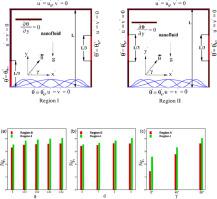International Journal of Mechanical Sciences ( IF 7.1 ) Pub Date : 2021-02-14 , DOI: 10.1016/j.ijmecsci.2021.106346 Krishno D. Goswami , Anirban Chattopadhyay , Swapan K. Pandit , Mikhail A. Sheremet

|
This paper is framed to analyze mixed convection flow features of a CuO - H1O nanoliquid within a partially heated wavy enclosure. The enclosure is embraced by the inclined magnetic field. In addition, the impact of Brownian motion is assimilated into the nanoliquid. Two models, namely the viscosity and the thermal conductivity depending on the Brownian motion of nanoliquid are used. The numerical solutions of the control equations constituting Navier-Stokes equations are carried out by adopting a compact finite difference scheme. Our computed results using some experimental data are compared to the results available in the literature and a nice resemblance is obtained. Numerical results for the specified problem are investigated by controlling the key characteristics such as nanoparticle concentration (), Richardson number (), Reynolds number (), Grashof number (), Hartmann number (), orientation angle of magnetic field (), number of undulations () and amplitude of wavy surface (). It is established that the angle and the position of the heating area play a crucial role in the liquid motion and heat transport inside the wavy cavity. The energy transfer rate can be augmented or diminished in presence of nanoparticles along with variations of Hartmann and Richardson numbers as well as the number of waviness of the bottom surface of the enclosure.
中文翻译:

波浪形部分加热外壳中磁纳米流体的布朗运动
本文旨在分析CuO-H 1的混合对流流动特征。在部分加热的波浪形外壳中的O纳米液体。外壳被倾斜磁场包围。另外,布朗运动的影响被吸收到纳米液体中。使用两种模型,即取决于纳米液体的布朗运动的粘度和热导率。通过采用紧凑的有限差分格式,对构成Navier-Stokes方程的控制方程进行数值解。我们将使用一些实验数据得出的计算结果与文献中提供的结果进行比较,并获得了很好的相似性。通过控制关键特性(例如纳米颗粒浓度(),理查森数(),雷诺数(),Grashof号码(),哈特曼数(),磁场定向角(),起伏数()和波状表面的振幅()。确定角度加热区域的位置在波状腔内部的液体运动和传热中起着至关重要的作用。在纳米颗粒的存在下,随着哈特曼和理查森数的变化以及外壳底表面的波纹数的增加,能量传递速率可以增加或减小。











































 京公网安备 11010802027423号
京公网安备 11010802027423号